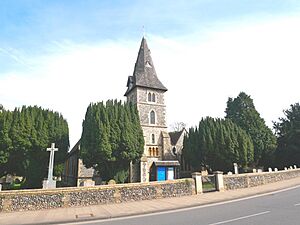St Mary the Virgin, Hayes, Bromley facts for kids
Quick facts for kids St Mary the Virgin, Hayes, Bromley |
|
|---|---|
 |
|
| Country | England |
| Denomination | Church of England |
| Administration | |
| Parish | Old Hayes |
| Diocese | Rochester |
St Mary the Virgin is a beautiful old church in South London. It was first built way back in the 1100s! Over the years, especially in the 1800s, it was updated with new designs by famous architects Sir George Gilbert Scott and his son John Oldrid Scott. The church is named after St Mary the Virgin. Today, it looks like a large hall with wide open spaces inside.
Contents
Where is St Mary's Church?
This church is found in a part of Bromley called 'Old Hayes'. Long ago, this was the original village area. In the 1860s, when the railway came through from Charing Cross, it split the village in two. The church stayed in the older, historic part.
A Look at the Church's History
The church is more than 800 years old! It has changed a lot over time, especially during the Victorian era (the 1800s).
How the Church Grew Over Time
- In 1856, a new section called the north aisle was added.
- The church tower was updated in 1861.
- Later, in 1879, another section called the south aisle and an organ area were built.
These expansions were managed by George Gilbert Scott and his son John Oldrid Scott. They made sure the new parts matched the old, simple style of the medieval church. You can still see arches from the 1200s along the north and south walls. Many old church furnishings were removed during these updates. However, the wooden roof beams from the 1400s and a small, tall window at the back of the main church area are still there. In 2005, a meeting room was built at the back of the church. Many local groups and clubs use this room today.
Famous People Connected to St Mary's
St Mary's was the local church for two British Prime Ministers:
William Pitt the Younger was even christened (baptized) here! There is a special memorial on the wall inside the church to remember them. This memorial was paid for by the government. Both Prime Ministers lived across from the church in a large house called Hayes Place. This house was also home to Everard Hambro.
Another important person, Sir Vicary Gibbs, also attended this church. He is buried in the churchyard. Inside the church, there is a monument that tells about his life. The churchyard is also the resting place of John Panis. He was brought here as an enslaved Native American and passed away in 1763.

